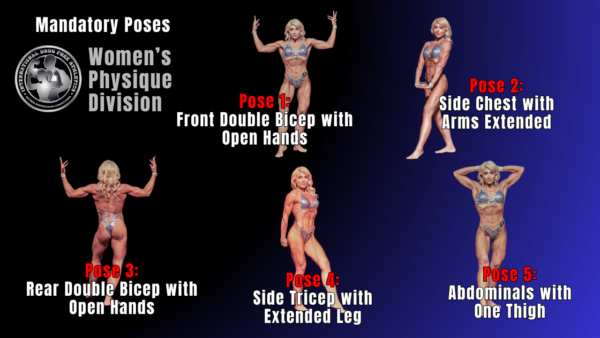This detailed breakdown of the Women’s Physique Division within the IDFA outlines everything an athlete needs to know before stepping on stage. Whether you’re a novice or a seasoned pro, understanding these guidelines is crucial for success in competition.
Is Women’s Physique for You?
 Whether you’re a seasoned competitor or stepping on stage for the first time, Women’s Physique is where strength, symmetry, and femininity come together. You present a physique that is both muscular and refined, with each muscle group reflecting your dedication and perseverance in training. Women’s Physique competitors should have the overall aesthetics and look of the Figure division, but with a little more overall muscularity. A strong V-taper, coupled with a powerfully developed lower body, will showcase what the human body and spirit are truly capable of.
Whether you’re a seasoned competitor or stepping on stage for the first time, Women’s Physique is where strength, symmetry, and femininity come together. You present a physique that is both muscular and refined, with each muscle group reflecting your dedication and perseverance in training. Women’s Physique competitors should have the overall aesthetics and look of the Figure division, but with a little more overall muscularity. A strong V-taper, coupled with a powerfully developed lower body, will showcase what the human body and spirit are truly capable of.
Confidence is key, and you command the stage with a presence that captivates both the audience and the judges. Your posing, delivered with precision, fluidity, and grace, will not only highlight your strength but also celebrate your femininity. This is your moment to inspire, to lead, and to show the world the incredible potential of a woman’s physique.
Have questions or need more information? We’re here to help. Contact Shaun or join our Free Facebook group, IDFA Room, to connect with fellow competitors and get inspired.
Athlete Attire: What do you Wear?
Posing Suit:
- Competitors will wear a Two-piece posing suit that crosses over and attaches in the back.
- G-strings, thongs, or bottoms that are too low in the front or back are not allowed.
- Must be in good taste and approved by the IDFA prior to competition.
- Worn during both the Judging round and Presentation & Awards round.
- All suits will be checked at Athlete Registration/Check-in.
Jewellery:
- Earrings, bracelets, and wedding rings are permitted.
- Jewelry should complement your look without overpowering or distracting from your physique
Classes: Where do you Fit?
Novice Women’s Physique:
- Competitors who have not placed in the top 3 in an Open class equivalent in another organization or in the Novice class in an IDFA sanctioned event.
- If more than 10 competitors, there will be 2 classes divided evenly and fairly based on height.
Open Women’s Physique:
- Competitors who have placed top 3 in the Novice class in an IDFA sanctioned event or in the Open class equivalent in another organization.
- If more than 10 competitors, there will be 2 classes divided evenly and fairly based on height.
- Winners of the Open class will earn IDFA Pro Status, provided there are at least 3 athletes in the class.
Masters 40+ Women’s Physique:
- Competitor is at least 40 years of age on day of competition.
- One class for all Masters 40+ Women’s Physique competitors.
Masters 50+ Women’s Physique:
- Competitor is at least 50 years of age on day of competition.
- One class for all Masters 50+ Women’s Physique competitors.
Pro Women’s Physique:
- Competitors who hold a current IDFA Pro Card
- Competitor has earned Pro Status in a recognized natural organization and has been approved to compete in the IDFA Pro Division. The IDFA must approve this prior to competition.
- One class for all Pro Women’s Physique competitors.
Crossovers: Competing in Multiple Classes & Divisions
- Masters 40+: Competitors in the Masters 40+ class can also enter the Novice and/or Open classes.
- Masters 50+: Competitors in the Masters 50+ class have the option to enter the Novice and/or Open classes. Additionally, they can also compete in the Masters 40+ class.
- Novice Competitors: Novice competitors may be allowed to enter the Open class as well, but this requires approval by the Promoter on a show-by-show basis.
- Multiple Divisions: Athletes are allowed to enter more than one Division in the same show. For example, you can compete in both Women’s Physique and Figure, or in Men’s Bodybuilding and Men’s Classic Physique at the same event.
This flexibility allows you to showcase your physique across different divisions and classes, maximizing your competitive experience and opportunities to shine on stage.
Judging Criteria: How will you be Judged?
Judges will assess:
- Muscular Development: Emphasis is placed on well-developed, full muscle bellies, with balanced development between the upper and lower body.
- Muscle Separation: Clear muscle separation is required, with a small amount of striations being acceptable.
- Leanness and Conditioning: Judges look for good leanness and conditioning, along with healthy, shapely muscularity.
- Balance, Proportion, and Symmetry: Competitors should exhibit balance, proportion, and symmetry in both muscularity and conditioning.
- Aesthetic and Look: Women’s Physique competitors should have the overall aesthetics and look of the Figure division but with a bit more overall muscularity.
Judging Round: What do you have to do on stage?
Competitors will:
- Line up in numerical order, facing the front in a Front Relaxed pose.
- Execute a series of mandatory poses as directed by the Head Judge.
Mandatory Poses:
- Front Double Bicep with Open Hands Pose
- Side Chest with Arms Extended Pose (choice of side)
- Back Double Bicep with Open Hands Pose
- Side Tricep with Extended Leg
- Abdominals and Thigh Pose
Presentation & Awards Round: Amateur (Novice, Open, Masters)
- Competitors perform a Free Posing Round to background music, lasting 30 to 45 seconds, highlighting 4-6 poses.
Presentation & Awards Round: Pro
- Pro competitors perform a 60-second Posing Routine with music provided in advance (MP4 format preferred).
- No required mandatory poses. Competitors choose poses that best showcase their physique.
- Scoring mainly occurs during the Judging Round, but the Presentation Round may act as a tiebreaker.
- No props or costumes allowed.
Awards Presentation:
After the presentation round for each competitor in the class is completed:
- All competitors in the class will exit the stage behind the curtain. If there are 5 or fewer competitors in the class, they will remain on stage.
- The top 5 competitors will be called back to the stage, in no particular order, to the back line. Awards will be handed out to the top 5 on stage during the show. Note: Every athlete in the class will get an official placing on the IDFA website after the show.
- The awards presenter will place a medallion around your neck as you line up on the front line of the stage. Competitors will be arranged in order from 5th to 1st place. The top 5 placements will be officially announced on stage.
- After the awards are handed out, a photo will be taken of the Top 5, then the Top 3, and finally, a solo photo with the Winner.
- Note: For the Pro Classes we will Official place every one of them on the stage at the event. For example, if we have 8 Pro competitors, we will place them 8th to 1st place at the show with medallions.
Award Details:
- Amateur: The Top 3 will receive Large IDFA Custom Medallions, while 4th and 5th place will receive smaller IDFA medallions.
- Pro: The Top 10 will receive Large IDFA Custom Medallions. Cash prizes may be awarded, and these will be announced prior to the event.
This is the process for awarding competitors in all classes, ensuring a clear and organized presentation.
JUDGING – ONLINE COMPETITIONS
Submitted Competitor Photos and Videos will be compared against the Photos and Videos of the other competitors in your class. Official IDFA Judges will be individually and privately going over all of the competitor Photos and Videos and comparing them and ranking them from 1st place to the final placing and submitting them to the IDFA as their official placings just as we do at our Live Competitions. All competitors will be placed.
PHOTOS and VIDEO SUBMISSIONS – ONLINE COMPETITIONS
We will need a photo of each mandatory pose. We will also need a VIDEO of you performing all the mandatory poses.
For the Photos and Video make sure we see your entire body from the bottom of your foot to the top of your head. You can not edit or use filters on the Photos and Video. For the Video, if you are using your phone, hold it upright (or vertically). We will be putting together a Contest Coverage and Results video for every online competition.
To validate the date we will need one photo of you holding a piece of paper with the code word on it. We will be emailing the code word out to all the athletes late the evening before the online competition.
Send your Photos and Videos submissions to info@idfa.ca. We can also use sending files sites such as DropBox, Wetransfer, etc. If you prefer another method for sending Photos and Videos please email Shaun at info@idfa.ca. The main file sharing programs we use are Dropbox and WeTransfer.
If you have any questions please message Shaun at info@idfa.ca.
This comprehensive guide ensures that you’re fully prepared for every aspect of the competition, from attire to posing and judging criteria. Whether you’re just starting or aiming for the Pro division, this information will help you present your best self on stage.










